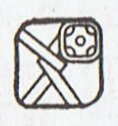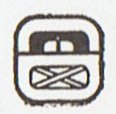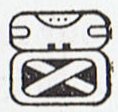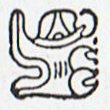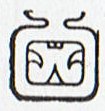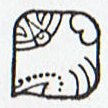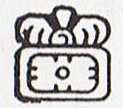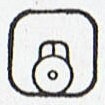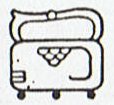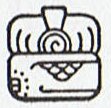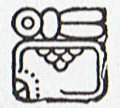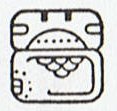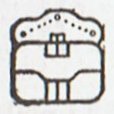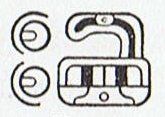The end of side a on the Mamari tablet was 8 nights after Spica was close to the Full Moon:
Regulus culminated at midnight in April 6, i.e. 200 days after March 21.
April 6 can be read as 4-6 and 46 = twice 23. There were probably 2 kings on Easter Island, both the 'little king' (Regulus, α Leonis) and Al Melik. The star Sadalmelik (α Aquarii) culminated at midnight in October 9, when Spica was close to the Full Moon.
In my presentations so far I have avoided to also include such midnight culminations of important stars which would have been visible at the nakshatra dates. But I am now forced to include them:
The glyph type at April 6 is raaraa ('central ceremonial ground').
 |
 |
|
raaraa |
*Ca14-19 |
Honu paka can be contrasted with honu kau. First the 'turtle' (honu) is dry (paka), but then she is 'swimming' (kau). Metoro may have thought of the culminating Aquarius stars.
| Paka 1. Dry; to become dry (of things); pakapaka, to dry out. Te paka is also the name of the moss-covered areas, between the small lakes of volcano Rano Kau, through which one can pass without getting one's feet wet. 2. To go, to depart; he-paka-mai, to come; he-oho, he-paka, they go away. 3. To become calm (of the sea): ku-paka-á te tai. Pakahera, skull, shell, cranium; pakahera puoko tagata, human skull; pakahera pikea, shell of crab or crayfish. Gutu pakapaka, scabbed lips. Hau paka, fibres of the hauhau tree, which were first soaked in water, then dried to produce a strong thread. Moa gao verapaka, chicken with bald neck. Ariki Paka, certain collateral descendents of Hotu Matu'a, who exercised religious functions. Vanaga.
1. Crust, scab, scurf; paka rerere, cancer; pakapaka, crust, scabby. 2. Calm, still. 3. Intensive; vera paka, scorching hot; marego paka, bald; nunu paka, thin. 4. To arrive, to come. 5. To be eager. 6. To absorb. 7. Shin T. Pakahera, calabash, shell, jug. Pakahia, to clot, curdle, coagulate. Pakapaka, dry, arid, scorching hot, cooked too much, a desert, to fade away, to roast, a cake, active; toto pakapaka, coagulated blood; hakapakapaka, to dry, to broil, to toast. Pakahera pikea, shell of crab or crayfish. Churchill. |
| Kau 1. To move one's feet (walking or swimming); ana oho koe, ana kau i te va'e, ka rava a me'e mo kai, if you go and move your feet, you'll get something to eat; kakau (or also kaukau), move yourself swimming. 2. To spread (of plants): ku-kau-áte kumara, the sweet potatoes have spread, have grown a lot. 3. To swarm, to mill around (of people): ku-kau-á te gagata i mu'a i tou hare, there's a crowd of people milling about in front of your house. 4. To flood (of water after the rain): ku-kau-á te vai haho, the water has flooded out (of a container such as a taheta). 5. To increase, to multiply: ku-kau-á te moa, the chickens have multiplied. 6. Wide, large: Rano Kau, 'Wide Crater' (name of the volcano in the southwest corner of the island). 7. Expression of admiration: kau-ké-ké! how big! hare kau-kéké! what a big house! tagata hakari kau-kéké! what a stout man! Vanaga.
To bathe, to swim; hakakau, to make to swim. P Pau., Mgv., Mq.: kau, to swim. Ta.: áu, id. Kauhaga, swimming. Churchill.
The stem kau does not appear independently in any language of Polynesian proper. For tree and for timber we have the composite lakau in various stages of transformation. But kau will also be found as an initial component of various tree names. It is in Viti that we first find it in free existence. In Melanesia this form is rare. It occurs as kau in Efaté, Sesake, Epi, Nguna, and perhaps may be preserved in Aneityum; as gau in Marina; as au in Motu and somewhere in the Solomon islands. The triplicity of the Efaté forms [kasu, kas, kau] suggests a possible transition. Kasu and kas are easy to be correlated, kasu and kau less easy. They might be linked by the assumption of a parent form kahu, from which each might derive. This would appear in modern Samoan as kau; but I have found it the rule that even the mildest aspirate in Proto-Samoan becoming extinct in modern Samoan is yet retained as aspiration |
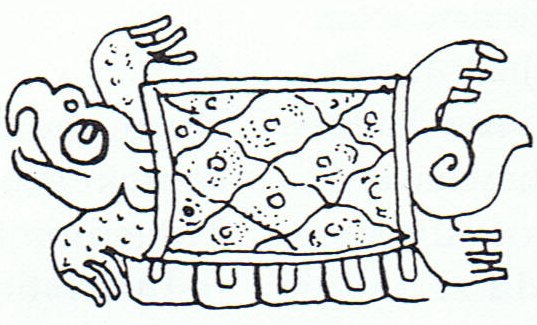
In this Mayan version of the Swimming Turtle her eye is depicted to draw attention. We can compare with the pair of similar eyes in the last and only 5-day long month Vayeb.
|

